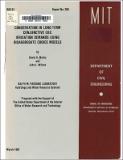| dc.description.abstract | Section 1:This report presents the hierarchy of sub-problems involved in modelling the demand for conjunctive use. An historical description of the development of conjunctive user irrigation and a review of current policy initiatives of local water management institutions support the contention that the prime determinants of the demand for new conjunctive use systems for irrigation are their profitability and local water policies. The possible future implementation of comprehensive water management policies needs to be explored by 1) examining the institutional objectives of local water management agencies, and 2) developing a predictive model of the acceptance of conjunctive use policies by irrigators. The research needs identified in this section are further developed in Section II (Institutional Objectives in Conjunctive Management of Surface and Groundwater) and Section III (Predicting the Acceptance of Water Conservation Policies by High Plains Irrigators: An Application of Probabilistic Choice Modelling). Section 2: Local irrigation agencies are not centralized institutions with complete power over all surface and groundwater decisions in their basins. Instead, the three major types of irrigation agencies: public irrigation districts, mutual water companies and commercial water companies have different and relatively limited powers. Most importantly, with certain exceptions, they cannot directly control excessive groundwater withdrawals and have to resort to indirect methods to achieve this goal. The study of the decision-making process of two important types of local irrigation agencies, public irrigation districts and mutual companies can be simplified by hypothesizing that these agencies have similar objectives. However, single objective models should be discarded because they fail to predict actual decisions. Instead, multi-objective models should be used: aggregate profit maximization, local control, conflict resolution, equity and internal motives play an important role in shaping the choice between different policies. An accurate analysis of the nature and objective of irrigation agencies paves the way for the construction of detailed conceptual models of the decision-making process of these institutions. These models can either predict or describe the behavior of a particular agency and can be incorporated into a general framework suitable for the analysis of most issues relating to the conjunctive management of surface and groundwater. Section 3: This study addresses the groundwater depletion problem in the Ogallala aquifer beneath the High Plains and examines the suitability of probabilistic choice models for predicting the acceptability of alternative water conservation policies to the irrigators. The nature of the policy acceptance problem is discussed and the social, institutional, and legal environments present on the High Plains are described. An overview of choice models and behavioral factors of individual information processing is presented. Use of the Elimination by Aspects (EBA) model and the Luce choice model is explored in the context of predicitng the degree of acceptance of alternative water conservation policies by irrigators. The existing and proposed policies of the groundwater management districts on the High Plains are reviewed and their characterization in terms of aspects is proposed. These alternatives are then used in an experimental application of the EBA and Luce choice models. Two laboratory experiments are conducted to examine the performance of these models in the context of predicting water conservation policy acceptance. The experiments confirm the validity of the regularity and moderate stochastic transitivity assumptions (EBA model) and the multiplicative inequality (both models) but do not confirm the validity of the similarity hypothesis (EBA model), or the constant ratio rule and strong stochastic transitivity (Luce's model). In the experiments, the EBA model was a more accurate predictor of the choice probabilities than Luce's model. Furthermore, use of the EBA model appears to be most appropriate for problems characterized by many feasible alternatives which can be described by many concrete aspects which are easily recognized by the decision makers. Recommendations are made concerning field applications of the EBA model and future research needs of predictive choice modelling. | en_US |
